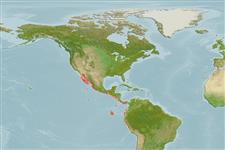>
Ophidiiformes (Cusk eels) >
Ophidiidae (Cusk-eels) > Ophidiinae
Etymology: Lepophidium: Latin, lepus, leporis = rabbit + Greek, ophis = serpent (Ref. 45335).
More on author: Gilbert.
Environment: milieu / climate zone / depth range / distribution range
Ökologie
seewasser demersal; tiefenbereich 73 - 307 m (Ref. 91765). Subtropical; 30°N - 21°N, 118°W - 108°W (Ref. 91765)
Eastern Pacific: Gulf of California and along the outer coast of Baja California as far north as Bahía Sebastían Viscaíno.
Size / Gewicht / Alter
Maturity: Lm ? range ? - ? cm
Max length : 41.5 cm TL Männchen/unbestimmt; (Ref. 86316)
Kurzbeschreibung
Morphologie | Morphometrie
Rückenflossenweichstrahlen (insgesamt): 117-128; Afterflossenweichstrahlen: 97 - 108; Wirbelzahl: 66 - 70. This fine-scaled species have the following characteristics: pyloric caeca usually 5-6, typically 5 + 1; usually 3 rudimentary gill rakers on the upper arm of the first arch and 4-5 developed rakers on lower arm with 2-5 rudimentary rakers anteriorly, total gill rakers usually 11-12 (10-15); count of scale rows almost 30 between the occipital line and the dorsal-fin origin, 14-15 rows between the dorsal-fin origin and the lateral line, and about 255 lateral scale rows; dorsal-fin origin between neural spines 4-5 (rarely between 3-4); color of head and body rather uniformly dusky, silvery, or whitish along the belly; dorsal fin usually lacks a dark edge, and when present it is poorly developed; anal fin has an inconspicuous and narrow dark edge; orobranchial cavity usually pale, but the rear of the roof of the mouth may be dusky; esophagus blackish; stomach and hindgut pale (Ref. 91765).
Occurs benthically, from 210-307 m in the Gulf of California and 73-293 m on the outer coast (Ref. 91765). Oviparous, with oval pelagic eggs floating in a gelatinous mass (Ref. 205).
Life cycle and mating behavior
Geschlechtsreife | Fortpflanzung | Ablaichen | Eier | Fecundity | Larven
Robins, C.R., R.H. Robins and M.E. Brown, 2012. A revision of Lepophidium (Teleoastei, Ophidiidae), with descriptions of eight new species. Bulletin of the Florida Museum of Natural History 52(1):1-94. (Ref. 91765)
IUCN Rote Liste Status (Ref. 130435)
Bedrohung für Menschen
Harmless
Nutzung durch Menschen
Mehr Information
NamenSynonymeMetabolismusRäuberÖkotoxikologieFortpflanzungGeschlechtsreifeAblaichenSpawning aggregationFecundityEierEientwicklung
Alter/GrößeWachstumLänge-GewichtLänge-LängeLängenhäufigkeitenMorphometrieMorphologieLarvenLarven Pop.Dyn.RekrutierungDichteBRUVS
ReferenzenAquakulturAquakultur ProfilZuchtlinienGenetikElectrophoresesVererbbarkeitKrankheitenVerarbeitungNutrientsMass conversion
Tools
Zusatzinformationen
Download XML
Internet Quellen
Estimates based on models
Preferred temperature (Ref.
123201): 12.1 - 15.6, mean 14 °C (based on 46 cells).
Phylogenetic diversity index (Ref.
82804): PD
50 = 0.5000 [Uniqueness, from 0.5 = low to 2.0 = high].
Bayesian length-weight: a=0.00219 (0.00121 - 0.00395), b=3.15 (2.99 - 3.31), in cm total length, based on LWR estimates for this species & Genus-body shape (Ref.
93245).
Trophic level (Ref.
69278): 3.7 ±0.7 se; based on size and trophs of closest relatives
Widerstandsfähigkeit (Ref.
120179): mittel, Verdopplung der Population dauert 1,4 - 4,4 Jahre. (Preliminary K or Fecundity.).
Fishing Vulnerability (Ref.
59153): Low to moderate vulnerability (32 of 100).
